https://www.integralworld.net/philanderson1.html  Phil Anderson has a background in electronics hardware design and software engineering, he has spent the last few decades engaged in various Internet-related entrepreneurial activities. An epiphany that occurred in 2007 when trying to model the process of evolutionary emergence using engineering control theory concepts led Phil to the idea of Holons, Holarchies and Wilber’s Integral theory, although because of how Phil arrived at Integral thinking, he retains his own unique holonic Integral perspective. Phil Anderson has a background in electronics hardware design and software engineering, he has spent the last few decades engaged in various Internet-related entrepreneurial activities. An epiphany that occurred in 2007 when trying to model the process of evolutionary emergence using engineering control theory concepts led Phil to the idea of Holons, Holarchies and Wilber’s Integral theory, although because of how Phil arrived at Integral thinking, he retains his own unique holonic Integral perspective.A FULLY HOLONIC META-THEORY FOR THE HEART OF INTEGRALPHIL ANDERSON
ABSTRACTA clarified Integral model of holons and holarchies is presented which, though simple and elemental in essence, may nevertheless be expanded into extremely detailed and descriptive applications through the use of self-similar recursive patterns. New holonic distinctions are described, supported by evidence for the distinctions in the natural world. The model is also mapped against a variety of Integral theories and human stage theories to demonstrate that many of the key distinctions they describe can be defined in terms of a single more elemental holonic theory that underlies all of them. INTRODUCTIONMany (if not all) Integral ideas and theories are based implicitly or explicitly on an underlying concept of holons and holarchies, usually from the perspective of looking at some specific problem or situation through a holonic lens [1]. Many of these theories have resonating insights, some theories have important unique insights, and many of these insights turn out to be insights that are generally applicable to all holons in the “atoms to humans” natural holarchy. Through a meta-analysis of holon-based theories, together with a detailed analysis of the natural holarchy spanning from sub-atomic particles to humans, several insights emerge which extend the core definition of holons in some very simple but powerful ways. In a sense, my intention here is to step back from all of today’s holon-based theories and meta-theories into a more abstract space in order to clarify the underlying holonic reality description that I feel may sit at the heart of all of them. This writing is intended for people already familiar with the concept of holons and holarchies. Where I refer to “the holarchy”, I’m referring to the atoms to humans holarchy described by Ken Wilber (depicted in the diagonals in Figure 2). I will also be assuming some familiarity with the stages identified in Spiral Dynamics (SD) and some familiarity with Wilber’s AQAL Integral theory. The first sections of this writing are concerned with an overview of holons as currently defined and an explanation of the conceptual foundations I’ll be using throughout, followed by a section introducing a new idea of “holon types” with explanation and examples. This is followed by sections on holonic emergence and recursion and several sections discussing foundations and limitations of holonic thinking. The remaining sections map my work to that of other Integral thinkers. CONTENTS
HOLONICS AS IT EXISTS TODAYThe term “holon” first appeared in Arthur Koestler’s “The Ghost In The Machine”, and is used to describe a pattern visible in reality whereby all entities of all types can be regarded as whole / part entities. That is to say, all entities have their own identity but can also be found to exist as a part of a higher order identity. The pattern can be found at all levels of reality, for example: atoms have their own identity, but atoms can also exist as part of a chemical molecule. At the other end of the organizational complexity scale, individual humans have their own identity (I) but can also be viewed as parts of a higher order entity of “society” (WE). A hierarchy of holons is called a holarchy, this is depicted in Figure 1. 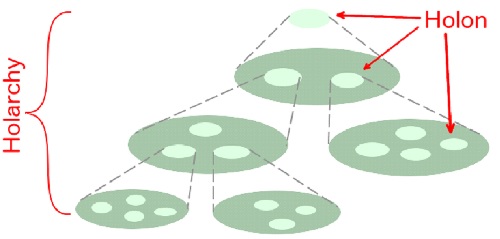 The concept of holons can be applied to all distinctions, so in a sense “everything is a holon”. The whole / part concept of holons effectively integrates all reality distinctions into a single interrelated system, since by their whole / part nature, all distinctions described as holons lack a fundamental dimension of separation. This fundamentally integrative quality of holonic perspectives is the reason why the underlying concept of holons has such a central place in Integral theories. As a consequence of a holon being a whole / part entity, a holon has in a sense 3 different domains or dimensions of experience. Considering a human as a holon, these are:
Ken Wilber’s holon-based 4 quadrant AQAL model shown in Figure 2 adds a 4th primary category to this list – ITS. 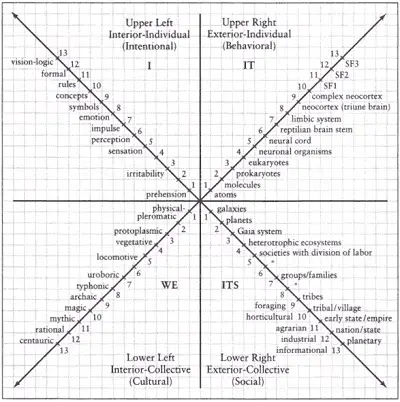 BEAUTY, GOODNESS AND TRUTHThe language used to describe the model which follows is based on the idea that reality can be viewed as having a fundamentally trichotomous or 3-dimensional nature. Evidence for this idea is immediately visible in the casual observation that space has 3 spatial dimensions and physical objects existing in space occupy 3 dimensions, but on further analysis, this 3D pattern runs very deeply throughout reality. For example – 3 primary colors underpin the entire spectrum of colors, in addition to having 3 spatial dimensions, physical objects have the 3 qualitative dimensions of solidity, texture and shape. Regarding the sound of human language, this too can be seen as having 3 primary dimensions of meaning: speech emphasis (volume), speech intonation (modulation of tone), and conceptual objective meaning of the words as sound objects. Many philosophers have used trichotomous classifications, and as an indication of how fundamental this pattern might be to some, the Christian God is described as a triune (trichotomy). As an aside, the fact that reality is seen as having an essentially 3-dimensional nature does not preclude the possibility of describing things in terms of a higher dimensionality, since (as will be explained later) each single dimension of a dimensionality within my model can be considered as itself consisting of 3 sub-dimensions, since this pattern repeats, this leaves the door open to N-dimensional reality descriptions. The underlying trichotomous nature of reality shows up in the holonic model itself as the 3 previously mentioned holonic domains of I, WE, IT. Whilst labelling these domains I, WE, IT can work adequately when using the holonic model to consider the holon reality of humans (and possibly other life forms), it’s a somewhat anthropocentric perspective which renders the holonic model less useful for considering other types of conceptual entities, entities which may in fact be reasonably described using a holonic model. For example: a space holon, a color holon, a sound holon. It also creates some confusion when considering humans at different developmental levels, because human “person perspectives” also unfold in a developmental sequence of 1st, 2nd, 3rd etc. person, so a way needs to be found to clearly differentiate fundamental holon “person perspectives” and developmental “person perspectives”. In order to make the model as broadly applicable as possible therefore, I will be using the concepts of Beauty, Goodness and Truth (BGT) to refer to a trichotomy of foundational transcendentals or fundamental “properties of being”, a trichotomy from which all other categories in reality follow and are conceptually contained within. From my own reflections I feel that it is valid to give the concepts of Beauty, Goodness and Truth this foundational position, although the idea also has some support elsewhere, e.g. Beauty, Goodness and Truth appear as transcendentals in Platonism and Christians might note that the catechism of the catholic church describes Beauty, Goodness and Truth as concepts which can be used as a starting point in “naming God”, (e.g. talking about fundamental reality) in statement 41 on Part one: The profession of faith. Using the concepts of Beauty, Goodness and Truth (BGT) as the 3 primary categories of a sparse ontology may extend the use of these concepts somewhat further than the reader is used to understanding them, however please bear in mind my intended use of these concepts going forward. Red, blue and green color coding will be used throughout the writing to represent these 3 primary concepts as follows: Beauty, Goodness and Truth. And as a first step in describing the model using the concepts of BGT, the holonic domains of I/WE/IT will be re-labelled in the following manner going forward, and referred to as holonic dimensions.
These holonic dimensions of Beauty, Goodness and Truth broadly equate to the UL, LL and UR+LR quadrants respectively of Wilber’s AQAL model shown in Figure 2. Beauty, Goodness and Truth in this holonic context are described by Ken Wilber on page 19 of Integral Spirituality variously as “dimensions of being”, “dimensions of reality” and “dimensions of experience”, and this trinary description is upheld in my model whereby BGT can be seen as dimensions of the reality we occupy (e.g. both spatial and qualitative dimensions), dimensions of perspective-space through which we perceive reality (e.g. dimensions of our mind), or dimensions of our actual being as a holon. As an aside: another way of looking at this is to say that each BGT holon dimension has sub-dimensions of being, reality and experience. The idea of holon dimensions having sub-dimensions is an important theme which I will return to later. Wilber’s 4 quadrant perspectives can still be differentiated within a trinary categorization because (as will be explained later) the two UL and UR quadrants appear as sub-categories of Truth rather than primary categories in their own right. As a diagram therefore, Figure 3 is essentially just a simple trinary version of Ken Wilber’s 4 quadrants with the I/WE quadrants re-labelled Beauty, Goodness and the IT and ITS quadrants temporarily combined into a single Truth dimension. 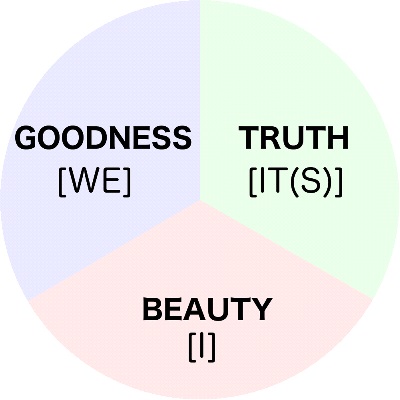 Although Figure 3 is a useful way to represent a holon as a conceptually bound entity (and as such, will be used going forward), it’s important to understand that a holon’s dimensions are orthogonal, so for example when considering Beauty, Goodness and Truth as a holon’s perspective-space, in many ways this is best conceptualized in terms of the 3D Cartesian diagram shown in Figure 4. Beauty, Goodness and Truth have relationships with each other, but none may be reduced to the others, each is a separate dimension in its own right. 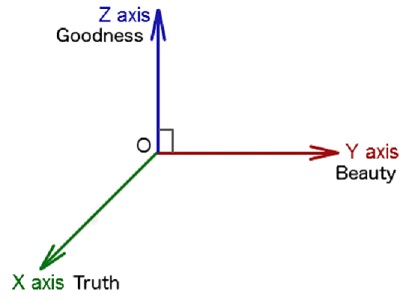 As a second step in describing the model in terms of BGT, holons and holarchies will be defined as an emergent property of Beauty, Goodness and Truth. So BGT are primary categories and the patterns in reality which we call holons and holarchies arise through the interplay of BGT. Summary:
Three types of holonJust as a holon has the 3 holonic dimensions of Beauty, Goodness and Truth, analysis of the holarchy reveals that each holon also always has an associated holon type that’s descriptive of how and what the holon will manifest and how the structure of its relationship with other equivalent holon entities will look, and this too will be one of either Beauty, Goodness or Truth (or I, WE, IT). The holon type manifests as a bias or dominant function in the holon’s systemics, a “Beauty(I)” holon will also manifest Goodness(WE) and Truth(IT), but the latter two attributes will be subservient to the dominant “Beauty(I)” function. This idea has superficial resonances with the idea of holon types as discussed by Ken Wilber, although holon types as described by myself are in addition to the holon types described by Ken, so the holon type sub-classifications I describe will potentially exist for each one of Ken’s holon types. The fact that sequentially emerging holons cycle repeatedly through manifesting the principles of Beauty, Goodness and Truth (or I, WE, IT) is most easily seen by examining human development stage theories, many of which contain evidence of this patterning. Although human stage theories refer specifically to human development, there’s evidence that the stage distinctions they describe show up as a repeating pattern over the entire range of the natural holarchy spanning from quarks to humans. Examples of Beauty, Goodness and Truth holon types as they show up in the Spiral Dynamics (SD) model are as shown in Table 1. 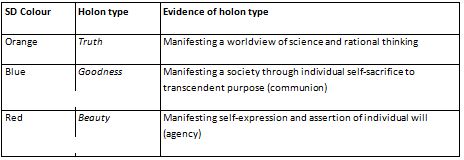 In the natural holarchy, the process of emergence sequentially cycles through the holon types of Beauty, Goodness and Truth, so the pattern described in the above table repeats all the way down the holarchy. The order is fixed and stages can’t be skipped, so in terms of emergence, a Goodness holon will always follow a Beauty holon, and a Truth holon will always follow a Goodness holon and so on. The diagram in Figure 1 depicts holonic stages found on the timeline of emergent complexity leading from the Big Bang to modern man. The spiral of emergence cycles repetitively though manifesting the principles of Beauty, Goodness and Truth. The process spirals outwards from a starting point shortly after the Big Bang, which as an event is located in the center of the diagram. It’s important to note that the chosen starting point of quarks/electrons is not the “start” of the spiral in an absolute sense, I would argue that the spiral effectively descends to infinity (into the Big Bang singularity), so in a sense it’s bottomless. However, the chosen starting point represents the lowest point on the spiral that’s known scientifically. 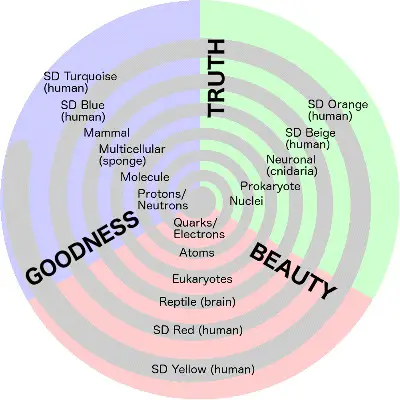 Note: whilst this may look a bit like a 3 domain version of Wilber’s AQAL diagram, this particular diagram is actually intended to depict IT, so the entire diagram belongs in the AQAL upper-right quadrant, SD stages are used here to identify human holons at different locations on the holarchy. The diagram is effectively a holon type differentiation of a single AQAL quadrant, categorizing each of the holon stages identified by Wilber as one of Beauty, Goodness or Truth holon types. A similar Beauty/Goodness/Truth diagram could be produced for each of the other AQAL quadrants. Although my model covers a larger span of the holarchy to the “atom to humans” span of Wilber’s AQAL model (Figure 1) and my labelling convention is somewhat different, there is intended to be a virtual 1-1 correlation between the stages in my model and the stages identified in the IT quadrant of Wilber’s model. Slight discrepancies will be discussed later in the section on Mapping to Wilber Integral Theory. What follows is a consideration of the structure and principles of the 3 BGT holon types, together with a consideration of the evidence that exists for those structures and principles in the natural world when looking at various locations on the holarchy. Often I describe things in terms of humans and human organizational structures because (due to their large scale), these holons are very visible and easy to analyze. It’s important to notice though that at some level (even if only in a very atomistic and elementary way) the properties and structures I am describing can be found in all holons of that type, from human societies all the way down to individual atoms and quarks. BEAUTY (I) HOLONSAn “in a nutshell” description of a Beauty holon might be “has a nucleus” or “has a single center of expression and control”, Beauty holon qualities are self-expression, differentiation, will and agency. For self-expression to occur decisively, control has to be centered in a single point inside the holon’s organizational system and (since a holon is created out of holons) this requires what amounts to a vertical power hierarchy inside the holon’s system of organization with a single constituent sub-holon (a dominant monad) having overriding control within the system. Considering human systems, if the required agenda is one of decisive and willful action there can be no space for “design by committee” or consensus based decision-making processes, since both of these will delay action and blur focus by bringing in multiple (possibly contradictory) perspectives. With an agenda of decisive action, a vertical power hierarchy is therefore a system requirement, and is the reason that the organizational structure of military and police forces are based on this type of holon. The following 3 diagrams illustrate the “has nucleus” structural similarity that underpins all Beauty holons: 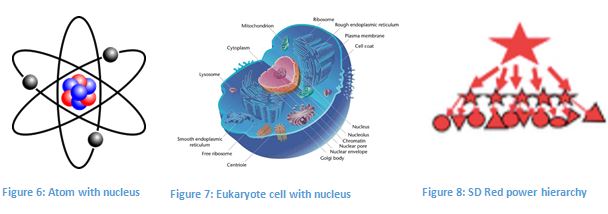 A governmental dictatorship based purely on the power and will of the dictator is an example of this sort of holonic organizational structure. The hierarchical organizational pattern is, however, visible throughout the holarchy as listed in Table 2.  GOODNESS (WE) HOLONSAn “in a nutshell” description of a Goodness holon might be “non-hierarchical multicellularity” or “lacks nucleus”. If a Beauty holon represents “thesis”, a Goodness holon represents “antithesis”, since the Goodness organizational principle of self-sacrifice and conformity is the opposite of the Beauty holon’s principle of self-expression. Unlike a Beauty holon which has a single dominant monad and a vertical power hierarchy in its organizational structure, a Goodness holon is characterized by a general lack of both of these things. Power hierarchies (or Beauty structures) are visible in both an SD Blue civilization and a pack of hunting dogs, but (as I will argue later), the power hierarchy is not the dominant function, rather – it’s a remnant from the previous worldview or previous (Beauty) holon emergence which nevertheless plays a necessary supporting role, since a holon always transcends but includes the reality of prior holons. Whereas the structure of a Beauty holon is formed through the agency of a dominant monad expressing through power relationships, the structure of a Goodness holon is formed by all constituent holons entering a relationship of exchange that involves sacrificing any self-expression which would stand in the way of the emergence and functioning of the Goodness holon. The Goodness holon itself, therefore, emerges as a non-hierarchical multicellularity organized around the transcendent purpose of community, or WE. The following 3 diagrams illustrate the structural “non-hierarchical multicellularity” similarity that underpins all Goodness holons: 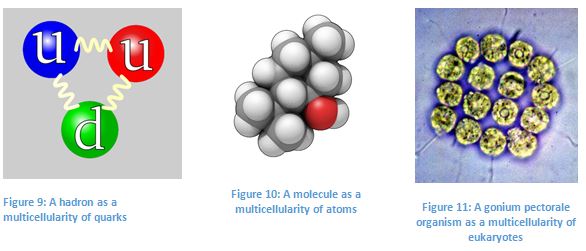 A traditionalist society based on religious values (e.g. a religious theocracy) is an example of a human society operating from this sort of holonic structure, where the required Goodness holon principle of surrender to transcendent purpose is achieved through surrender to God. The “Goodness holon” organizational pattern is visible throughout the holarchy, as listed in Table 3. 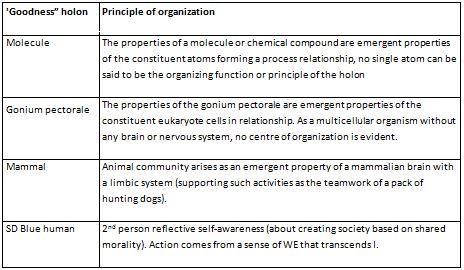 TRUTH (IT) HOLONSIf Beauty and Goodness holons represent thesis and antithesis respectively, a Truth holon represents synthesis. With the emergence of the Truth holon, a new space of possibility opens up in which Beauty and Goodness interpenetrate, and so are no longer in simple polar opposition. Example: in a simple “Goodness holon” multicellular organism such as a sponge (possibly the Earth’s first animal, followed by jellyfish), there is little differentiation to be found in its constituent eukaryote body cells since the sponge as a Goodness holon emerges through the Goodness principle of conformity, necessitating a lack of cellular individuality or differentiation. In the later “Truth holon” jellyfish however, we find tissue level cellular differentiation. On the one hand, this cellular differentiation and specialization can be viewed as increased Beauty self-expression of the individual jellyfish body cells, on the other hand the differentiations occur within groups of similar cells forming body tissue, this tissue can be regarded as a Goodness sub-community within the overall eukaryotic community of the multicellular jellyfish organism as a whole. As such, when compared to the sponge, the jellyfish with its tissue level differentiation of body cells demonstrates a higher order interpenetrating synthesis of Beauty and Goodness. Whilst it has no brain, a jellyfish (unlike a sponge) has a simple nervous system or neural net, and the interpenetrating synthesis of Beauty and Goodness occurs within the space of possibility provided by this neural net, which provides the integrating principle needed to form a coherent behavioral organism from the sum of its tissue differentiated body cells. The appearance of a neural net, therefore, represents the Truth emergence which defines a jellyfish as a Truth holon. At some level, each of the “Truth holon” organisms in the following 3 diagrams has as its defining feature a Truth structure which creates a new space for the interpenetration of Beauty and Goodness which was previously in polar opposition. 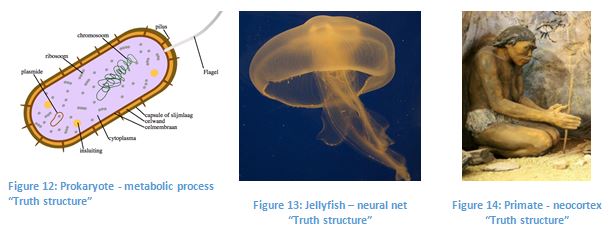 Key attributes of the above 3 Truth holons are listed in Table 4. 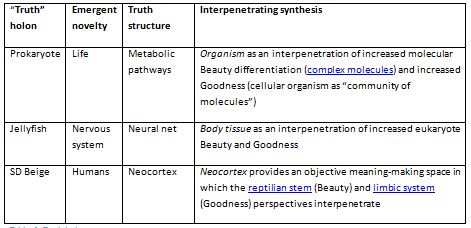 In terms of human society, democracy is an example of a Truth holon governmental construct where governments are chosen every few years on the strength of their argument, (unlike a Goodness-based religious theocracy) the perspectives and values of a democratically elected government can change quite significantly between elections. While democracy is a Truth holon governmental construct, it’s important to realize that this structure does not replace the previous (Goodness and Beauty) organizational structures, but rather sits on top of them. The premise for democracy is the underlying respect members in society have towards each other that enable us as individuals to accept the situation gracefully during an election if our preferred government does not get elected. This capacity for respect arises from our shared moral values (Goodness). These shared moral values may no longer be explicit (e.g. in Britain, the majority no longer share a single religion), but without a shared understanding of community Goodness, democracy would nevertheless be impossible as can be seen sometimes in countries at lower levels of development who attempt democracy and end up in civil war. The more elemental Beauty power structure is also still present in a democracy, and in fact is the power structure that supports the possibility of our Goodness moral values, and appears in the form of a police force and an army. A shared sense of community morality needs a police force to back it up since moral beliefs are based on ideas of reciprocity which break down if not enforced. So democracy is a rational Truth-based structure of governance, built on a given of a shared community morality and national identity (Goodness) which is in turn built on top of a power based system of control (Beauty) in the form of a police force and army. Each system transcends but includes its predecessor. BGT SPIRAL OF EMERGENCEBecause holons of holon types Beauty, Goodness and Truth emerge sequentially and in a fixed order, emergence can be depicted as a spiral of sequentially manifesting holons each with a holon type of Beauty, Goodness and Truth (Figure 15). Alternatively, this process can be visualized as a triple helix spiral which represents a co-evolution of Beauty, Goodness and Truth (Figure 16). 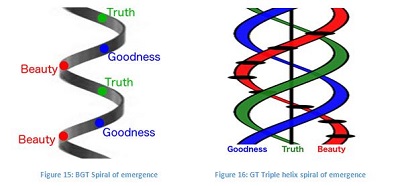 RECURSIVE BEAUTY, GOODNESS AND TRUTHA definition of holons is that a holon consist of holons. Including a theory in its own definition like this is called recursion, and it is the “infinity in a tin” aspect of recursion which gives holonics much of its conceptual power. It’s useful to understand that this recursion extends into all aspects of a holon’s definition including BGT dimensions and stages of emergence. Recursion in holonic dimensionsIf as stated at the beginning “everything is a holon”, it follows by simple logic that each of a holon’s dimensions are themselves (sub) holons. This logic is recursive, so each dimension of that sub-holon will itself be a (sub-sub) holon, and so on – all the way to infinity. Integral writer Steve McIntosh notes and describes this pattern as “The self-similar patterning of evolution’s Cosmogenetic Principle in nature, self, and culture”, depicted in Figure 17 taken from his writing where Subjective, Intersubjective and Objective relate to Beauty, Goodness and Truth respectively. 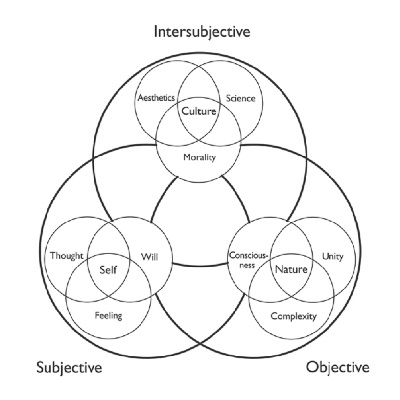 Although this recursive BGT patterning is perhaps more easily understood when it’s used to contain specific content as per Figure 17, an abstract representation of this idea of recursion is shown in Figure 18 where each BGT dimension of the depicted holon are differentiated recursively into sub-dimensions of BGT, each of which are themselves differentiated into sub-sub-dimensions of BGT. 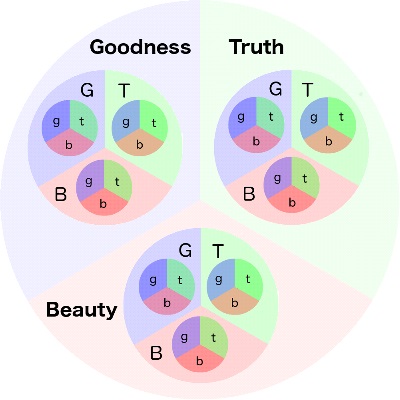 Two levels of recursive differentiation are shown in Figure 18, although our recursive differentiation could proceed to infinity, giving a model of infinite depth and granularity. In practice, only 1 or 2 levels of recursion will typically be found to be useful. For a practical example of recursive BGT analysis please see the appendix. However – recursively differentiating each dimension of a holon is only half of the story, in a sense this recursion is descending down into the holarchy of holon dimensions. In addition to descending down to infinity however, the holarchy of holon dimensions also ascends up to infinity, because (in the words of Ken Wilber) holarchies extend “all the way up and all the way down”. This means that, considering any holon, that holon must itself be a dimension of a bigger overriding holon that transcends and includes it, and since holon dimensions always have one of Beauty, Goodness or Truth associated with them, here we see the simple reason why holons in addition to having holon dimensions of BGT also have a holon type, which is one of B, G or T. The reason a holon has a holon type, therefore, is because any holon is always a (BGT) dimension of a higher order holon. RECURSIVE BEAUTY, GOODNESS AND TRUTHFigure 18 depicts a holon with holonic dimensions of Beauty, Goodness and Truth recursively differentiated into holonic sub-dimensions. However, because “everything is a holon” and BGT holons always consist of BGT sub-dimensions, the exact same recursive pattern we have identified above must exist within the spiral of emergence itself, namely – it must be true that every holon stage on the spiral of emergence can itself be differentiated into 3 sub-stages as shown in Figure 19. The idea of recursive holon sub-stages will be used later to explain sub-stages that appear in various developmental models. 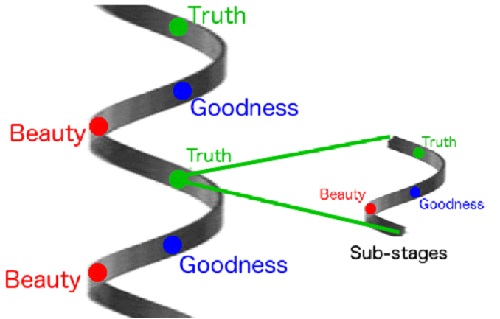 This recursive pattern extends in both directions, so whilst it is possible to differentiate each holonic stage into 3 sub-stages, it is also possible to group holonic stages into groups of 3 successive emergences and call this group of 3 a super-stage. Just as holons have a holon type, so too do groups of 3 sequential holons on the spiral, meaning an overall meta-systemic shift between the values of Beauty, Goodness and Truth is visible every 3 emergences as a meta-pattern within the spiral of emergence as shown in Figure 20. 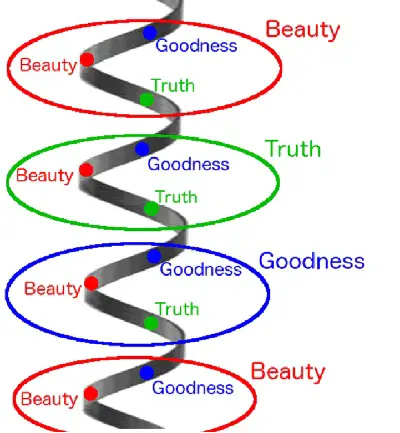 In a sense, the spiral of emergence is itself tracing a journey through an even bigger meta-spiral, the super-stages shown in Figure 20 can be considered stages which, if one were to step far enough back, would seem to be stages on a spiral exactly like those depicted in Figure 15. The idea of recursive holon super-stages will be used later to explain the developmental tier shifts that appear in various developmental models. Separating model from contentConsidered together, Figure 18 and Figure 19 (combined into Figure 21) provide a simple updated definition for holons that includes the insight of BGT holon types and the insight of recursion existing within all aspects of the model. 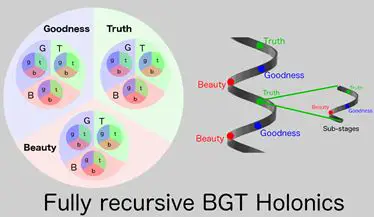 The model illustrated in Figure 21 is a fully abstract representation of a holon, since the holon contains no content whatsoever other than the recursive holonic model itself. Because it contains no content, the model itself as illustrated is applicable at any Kosmic address. However, adding content to the diagram (as will be done later in various examples) will always locate the diagram at a particular Kosmic address. Furthermore, considering the diagram of Figure 18, the view into the recursively differentiated BGT dimensions is always a view back down the holarchy, so once content has been added, the diagram can illustrate the reality of that holon and its constituent sub-holons but it cannot illustrate the view up the holarchy above the holon. This situation is, however, consistent with reality in the sense that a holon cannot see anything above the level of its own complexity. E.g. the layer of complexity in which you as a human being holon operate is completely out of sight to your individual eukaryote body cell holons and (further up the holarchy) Integral concepts and SD Yellow thinking is likely to be out of sight and so meaningless to holon-perspectives lower down the holarchy such as SD Blue. Note that recursion can be used to relate holon types as described by myself and holon types as described by Ken Wilber, since it could possibly be argued that my holon types exist as sub-type dimensions of his holon types (further work needs to be done to validate this). HOLONS IN 4 DIMENSIONSAs an integration of the 2 diagrams shown in Figure 21, it is interesting to consider a perspective from which a holon is a 4D space-time entity. Holons in timeAs described, a holon has a holon type which is defined by the type of the previous emergence. The fact that the previous emergence defines a holon in this important way is connected with Ken Wilber’s idea (“Sex, Ecology, Spirituality”, P70) that a holon’s significance is related to its depth, meaning the most significant emergences in a holon’s history of emergence are always the most recent. In addition to having a holon BGT type, a holon also has 3 BGT dimensions, and since recent emergences are the most significant, it’s reasonable to suppose that the 3 previous BGT emergences are the most significant emergences in a holon’s history in terms of defining the reality of its current 3 BGT dimensions. 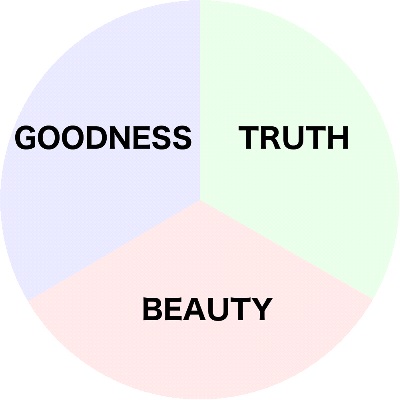 If we assume the holon in Figure 22 is a Truth holon, it’s history of emergence can be shown diagrammatically in the spiral of emergence depicted in Figure 23. The first emergence taking place at the bottom of the spiral is a Beauty holon, later in time a Goodness holon emerges and the final emergence depicted in the diagram is our Truth holon at the top of the spiral. Because these are the 3 most recent emergences in the holon’s history of emergence, it follows from earlier that the Beauty, Goodness and Truth stages depicted in Figure 23 are of primary significance in terms of defining the Beauty, Goodness and Truth dimensions depicted in Figure 22. 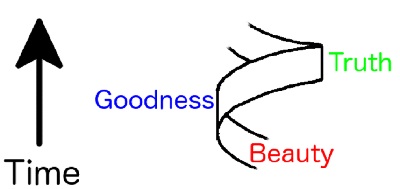 However – the vertical dimension in Figure 23 is the dimension of time. This illustration therefore depicts a temporal entity existing in the dimension of time, this entity has the temporally separated domains or dimensions of Beauty, Goodness and Truth. The entity can be considered as a whole, it has a start time (the point in time at the bottom of the spiral where Beauty appears) and an end time (the point in time at the top of the spiral where Truth appears) and can therefore be delimited as a discrete temporal entity. However, the temporal entity can also be considered a part, since if we to continue the spiral of emergence upwards, our holon would inevitably be transcended and included into a new higher order temporal holon at some point later in time, within which our current temporal holon is only a part. Because this temporal entity can be considered as a whole/part entity and has the separate domains or dimensions of Beauty, Goodness and Truth it meets a basic criterion for being considered as a holon. We can therefore consider this temporal entity as a time holon, this is illustrated in Figure 24. 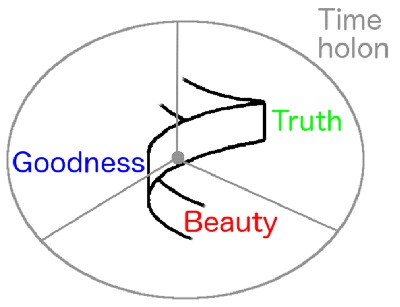 In fact, however, the time holon depicted in Figure 24 isn’t somehow fundamentally separate from the conventional holon depicted in Figure 22. Conventional holons are 3D (Beauty, Goodness and Truth) entities that occupy physical or conceptual space, but they also always occupy time. Figure 24 is therefore just a different view of the holon in Figure 22 depicting how it exists holonically in the dimension of time. Considering Figure 22 (a spatial view) and Figure 24 (a temporal view) as just different views of the same holon creates a 4D space-time view of a holon. Here, holonics is used to integrate time and space. In summary: a holon has 3 primary dimensions of Beauty, Goodness and Truth which occupy space, but also occupy time since these 3 primary dimensions were provided in the dimension of time by the 3 prior emergences. Holons in spaceAs depicted in Figure 22, a holon has 3 separate domains or dimensions, those of Beauty, Goodness and Truth. This illustration of a holon as a circle divided into its 3 constituent domains is a useful depiction of a holon as a conceptually bounded entity, however (as mentioned previously) in terms of how the dimensions of Beauty, Goodness and Truth relate to each other, a 3D spatial representation is a more accurate depiction because in holonics, Beauty, Goodness and Truth are regarded as orthogonal, e.g. are regarded as qualities that cannot be reduced to each other. This means if they are to be accurately represented in a diagram, they need to be considered as separate orthogonal spatial dimensions, as depicted in Figure 25. 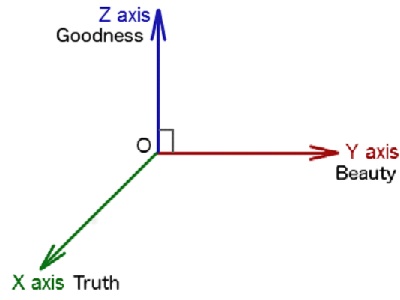 So in terms of the dimensionality of the conceptual space it occupies, a holon is a 3D spatial entity. As an aside, the truth of this claim can be verified with the simple real-world observation that the space we occupy is observed to have 3 dimensions and physical holons (e.g. atoms, molecules, bacteria, humans) appear as 3D “IT” entities in this 3D physical space. Notice that the same 3D physical space then in a sense provides as the container for their perspective dimensions of “WE” Goodness and “I” Beauty, since 3D space provides a stage for self-expression and relationship. Returning to the holon in Figure 22, we have seen that it is more reasonably represented as the 3D model depicted in Figure 25. And returning to the idea of a space-time holon, it is the 3D model of Figure 25 which therefore needs to be conceptually integrated with the extra time dimension depicted in Figure 24, emphasizing the fact that a holon is a 4D (space-time) entity. It’s not easily possible to visually depict a 4D entity in a 3D spatial diagram, so I have not provided a 4D space-time diagram of a holon. A 4D space-time holon thus described integrates the 2 separate diagrams shown in Figure 21 into a single conceptual entity. Note: in talking about a holon as a 4D space-time entity, this is best regarded as Minkowski space rather than a 4D Euclidean space, time is not literally a spatial dimension. An outcome of the 4D space-time nature of a holon is that Beauty, Goodness and Truth have a time dimension, therefore they are in some ways better described as process rather than object (e.g. Beauty, Goodness and Truth are in a sense verbs as well as nouns). For an example of how space fits into my holonic model, please see the appendix. POSTULATES OF HOLONICSReferences to “holonics” in this section refer specifically to my own holonic thinking and perspectives as contained in this writing. I would however argue that these postulates are visible in most if not all holonic / Integral thinking. Holonic postulates can be differentiated into 3 separate classes: asserted postulates (claims holonic thinking makes), assumed postulates (things used as implicit givens to build holonic perspectives) and undefined postulates (things simply omitted from the holonic model). If the holonic model is to have some sense of rigor about it, these need to be surfaced and examined. An implicit postulate of holonic thinking is that holonics provides a true mapping of reality, an asserted postulate of holonic thinking is the claim that a holon is a whole/part being. The second claim is a recursive claim because it’s defining a holon as being constructed from holons, e.g. it includes itself in its own definition. A useful thing about defining a model in terms of itself is that it can create a definition which escapes dependency on unresolvable givens. If I define a molecule as an entity created from atoms, that just creates the premise for the question – what are atoms made of? I can then define an atom as being constructed from sub-atomic particles, but then what are these constructed from? This is a useful enquiry (and the enquiry of high energy physics to explore), but at the same time – the premise for the enquiry means that the enquiry may never be fully answered, since the premise for the enquiry is that something is made from something which always leaves the question about what the last revealed something is itself made from. If, however, I take the premise that “something is made from something” and turn that premise into a concept and use that concept to form a theory, essentially I arrive at the theory of holonics which states: a holon is constructed from holons (something is made from something). With holonics, I can now define a molecule as a holon, and define a holon as something that’s built out of (sub) holons. With that, the description (through the use of recursion) does actually give a complete definition of a molecule in a vertical or “emergent complexity” sense. This definition of a molecule is very light on the specifics, although it’s still extremely useful to have an abstract concept for a molecule that rests on no concrete givens, e.g. it’s a fully abstract concept for a molecule. Because of the way humans have arrived at holonic perspectives, I would argue that holonic thinking has appeared at least in part as an emergent product of scientific rational enquiry into the nature of life and matter, because it is that enquiry which has revealed (holonic) patterns in nature, and therefore the successful scientific journey of exploration itself provides empirical evidence for the validity of holonic thinking. It’s important to notice the circularity present in this empirical foundation though, because the evidence we have found for the validity of holonic thinking (that “holons are made from holons”) was found through a process of pre-assuming the truth of our conclusion (a scientific analysis of nature made from the premise that “something is made from something”). At very least, therefore, evidence for the validity of holonic thinking has been cherry-picked. Due to the premise of our enquiry, we’ve only gathered evidence that supports the validity of holonic perspectives, whereas evidence that refutes the reasonableness of holonic perspectives will have been ignored due to the nature and premise of our way of looking for evidence. In short – we have only found what we were looking for. This criticism is certainly valid for my own writing, which is arguably based on presenting empirical evidence for holonic thinking (specifically, holon types) that’s been found through looking at reality from a holonic perspective, but I would argue that this situation is generally true for all holonic thinking (if not all human thinking from any perspective). Which is not to say that holonic perspectives are worthless, but it is a call for a bit of Integral caution and humility and the understanding that that holonic thinking is not some sort of absolute or fundamental truth resting upon unquestionable underpinnings. As an additional issue, although the last few hundred years of science has (with the aforementioned caveats) unearthed a holonic pattern in nature, it’s important to note that as it stands, the extent of the holarchy which has been empirically confirmed only stretches from quarks to humans. Although this is sufficient range for holonic patterning to be clearly visible, the range is extremely small considering that the holarchy (through its recursive definition) is posited to descend and ascend to infinity. For obvious practical reasons, this infinite extent hasn’t been validated and can’t be validated, and since it is based on nothing more than a simple extrapolation of a pattern visible in an extremely limited extent of the holarchy, it therefore exists in the model as a postulate. In my opinion, it is quite likely that the holonic model itself breaks down at some point, I am particularly skeptical that it is necessarily meaningful to extrapolate the holarchy vertically upwards indefinitely (as is commonly done in the Integral community). THE MISSING WESTERN 2ND PERSON PERSPECTIVEIt seems that in some areas of knowledge, we in the West omit consideration of the 2nd person perspective and since this issue affects the mapping of my model with various other theories, it’s worth spending a few minutes bringing this issue to the reader’s attention. Christian de Quincey in his paper “Intersubjectivity: Exploring consciousness from the second-person perspective” notes the following:
If a 2nd person perspective dimension has not been used in a stage theory, how might this show up in the representation of the theory? Since the spiral of emergence shown in Figure 15 is a 3D spiral and since these dimensions are qualitative holonic dimensions of BGT rather than spatial dimensions, when related to person perspectives the BGT dimensions relate to 1st, 2nd and 3rd person perspectives respectively. Because therefore omitting a person perspective equates to omitting a holonic dimension, it’s useful to consider how the 3D spiral of emergence appears in a 2D representation, this is shown in Figure 26. 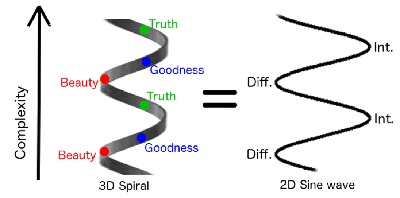 Notice how in a 2D representation, the 3D spiral appears as a sine wave oscillating between 2 different principles as complexity emerges over time. Just such a pattern shows up in many Western developmental theories, where the 2 different principles are usually labelled differentiation and integration, and I contend that wherever the pattern of differentiation and integration shows up in this context it’s simply a 2D representation of process that can also be represented as a 3D dialectic spiral of thesis, antithesis, synthesis (or in my model – Beauty, Goodness and Truth). As can be seen in the above diagram, if Beauty is equated with differentiation (a reasonable equivalence in my opinion), the point of maximum integration falls halfway between Goodness and Truth, this observation provides the following possible conceptual/temporal mapping of the 3D BGT representation with 2D differentiation/integration representation: Another possible mapping is that one of GT are simply dropped from consideration, e.g.: The following few sections describe how all of the above holonic insights map to the work of other Integral thinkers. MAPPING TO WILBER INTEGRAL THEORYAlthough Ken Wilber’s 4 quadrant AQAL model (Figure 27) is based on a holonic perspective, it differs from holonics as described by myself in that AQAL has 4 quadrants, versus the 3 holonic dimensions used in my model. 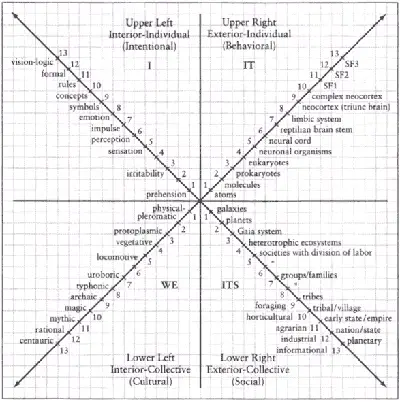 The underlying idea of quadrants shows up in 3 different ways in different contexts, these 3 different context-descriptions of the model relate to my own thinking as follows. Quadrants as 4 irreducible perspectives (AQAL Truth)In some contexts, the 4 quadrants are described as 4 irreducible perspectives, as stated by Sean Esbjorn-Hargens on integrallife.com “According to integral theory, there are at least four irreducible perspectives (subjective, intersubjective, objective, and interobjective)”. On the one hand, this statement seems to conflict with the illustration in Figure 30 where both right hand quadrants have been reduced to a single dimension, although this apparent contradiction can be resolved by considering the mapping to my model shown in Figure 28 (the diagram is based on Figure 17 by Steve McIntosh). 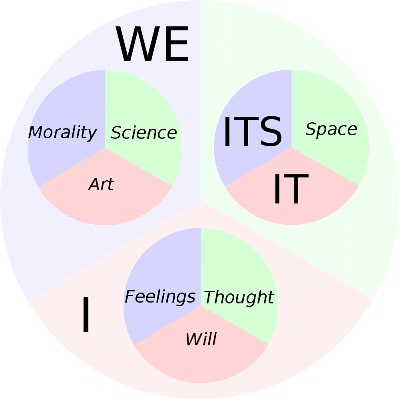 The above diagram depicts a (human) holon as described by my model with each of its holon dimensions (Beauty, Goodness and Truth) differentiated into 3 subordinate sub-dimensions of Beauty, Goodness and Truth. As can be seen, the AQAL domains of I and WE map to the holon’s primary Beauty and Goodness dimensions, whereas IT and ITS map to sub-dimensions of the Truth dimension. Small labels in italics represent possible holonic sub-dimensions that aren’t explicitly differentiated in Ken’s 4 quadrant AQAL model. Notice however that the difference between IT and ITS is a simple matter of perspective. Is an atom an atom (an IT) or is it electrons, protons and neutrons (ITS)? Both are correct “Truth” perspectives. So, on the one hand, it is true that perspectives of ITS and IT may not be reduced to each other, however both perspectives can be transcended and included into the single meta-perspective dimension of holonic Truth. Since “perspective” relates to Truth, I am classing this AQAL context as AQAL Truth. The quadrants as a pair of polarities (AQAL Beauty)In different contexts, the quadrants are described as a pair of orthogonal polarities, interior on the left quadrants versus exterior on the right quadrants, and individual on the upper quadrants versus collective on the lower quadrants, this polarity pair is depicted in Figure 29. Because this depiction describes a pair of orthogonal dimensions, this representation is a 2D representation and therefore does not map directly to my own 3D model, although the 2 polarity pair dimensions do relate to 2 particular dimensions of my model (specifically, Beauty and Goodness, as will be discussed later in the section on IMP). Since both polarities are subjectivity-polarities, I am classing this AQAL context as AQAL Beauty. 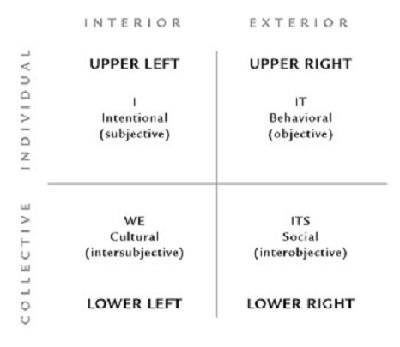 The Big Three (AQAL Goodness)The diagram of “the three value spheres” shown in Figure 30 (from integrallife.com) shows similar polarity mappings to Figure 29, although in the case of in Figure 30, the two right hand quadrants are combined into a single IT/S category. Considered as dimensions of value judgment, this three category representation is compatible with my 3D BGT dimensions. Since “value” relates to Goodness, I have categorized this AQAL context as AQAL Goodness. 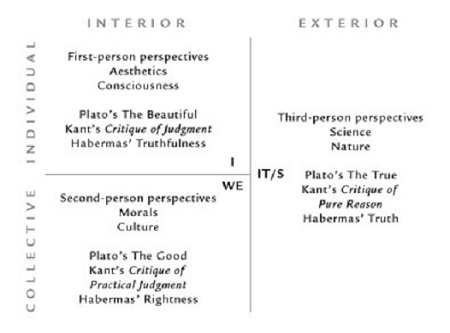 3D AQALAt the start of this writing, it was stated that holon dimensions can (as Ken puts it in Integral Spirituality) be regarded as: “dimensions of being”, “dimensions of reality” or “dimensions of experience”. Since these 3 dimensions are considered as sub-dimensions of holonic dimensions, and since each of the 3 quadrant context-descriptions qualitatively map to these dimensions, the above 3 AQAL context descriptions can be mapped as the 3 holonic dimensions of a 3D AQAL holon as shown in Figure 31. 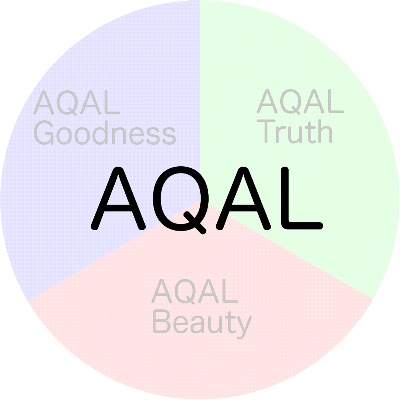 Integral Methodological Pluralism (IMP)Ken’s Integral methodological pluralism offers a map of 8 fundamental methodologies for gaining knowledge, in Ken’s words: “Integral Methodological Pluralism (IMP) involves, among other things, at least 8 fundamental and apparently irreducible methodologies, injunctions, or paradigms for gaining reproducible knowledge (or verifiably repeatable experiences)”, these fundamental methodologies are categorized into the 8 IMP zones shown in Figure 32. The 8 zones of IMP are defined by noting that in addition to considering the view through a quadrant, it’s also possible to consider the view from a quadrant. For example, I can explore the upper left quadrant (I) from the “inside” just by experiencing how my own subjectivity is (use phenomenology as a methodology), I can also explore the upper left quadrant from the “outside” by studying perspectives objectively (use structuralism as a methodology). 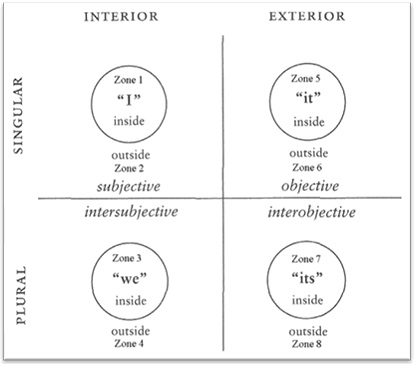 In my opinion, adding an extra distinction between the inside and outside of each quadrant is the perspective equivalent of adding an orthogonal dimension to the AQAL model, and therefore I am in general agreement with Lex Neale that the IMP zones of Figure 32 in a sense map to the 8 corners of his 3rd person AQAL cube shown in Figure 33. In this diagram, Ken’s AQAL square (Figure 27) appears as the below surface of the cube, and the “inside” of each quadrant appear as a new square on the above side of the cube. 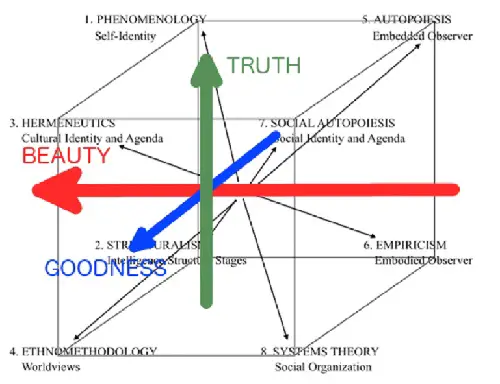 The colored arrows have been added to Lex’s diagram by myself and highlight the fact that by adding an extra polarity-dimension to the model, Ken’s quadrants as a 2D square of orthogonal polarities (Figure 29) has been raised to a 3D model that now maps directly to the 3D BGT dimensionality of my own model. For information on how each dimension in this cube has been categorized as B, G or T, please see the section on Mapping to AQAL Cube. Note how adding a 3rd dimension to the AQAL square opens up the 3D holon-space needed to contain the 8 fundamental methodologies as 3D (perspectival, relational and behavioral) content. It is important to highlight that the dimensions of BGT identified in the above cube do not map directly to the dimensions of BGT identified in the Figure 30 view of Ken’s square. In a sense, the 3 BGT dimensions in Figure 30 are repeating sub-dimensions of each BGT dimension in the above cube – this will hopefully be understood more clearly after reading the section on Mapping to AQAL Cube. Since Wilber’s square is a 3rd person map and since the cube in Figure 33 is Lex’s 3rd person cube, I agree with Lex that the 8 zones defined in IMP are just 8 of a possible 24 zones if all person-perspectives are considered (e.g. 1st and 2nd in addition to 3rd person). An example of a (2nd person) methodology which does not fit into the current 3rd person-only IMP mapping is: Intersubjectivity: exploring consciousness from the second-person perspective. Lines of development in holonic dimensionsKen Wilber notes that human development is typically not consistent in all domains, but that an individual can be at a high level of development in one domain whilst at a low level of development in some other different domain. Some of these different domains are shown grouped into the 2 different categories of Figure 34 and Figure 35 from integrallife.com. 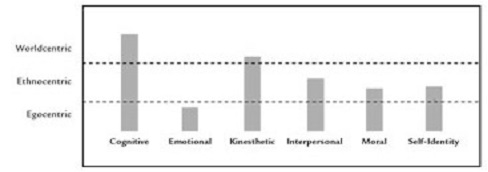 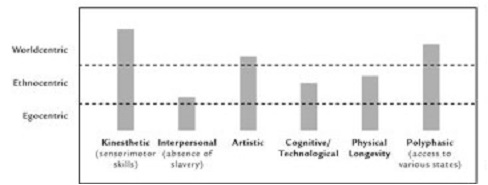 Holonics as described by myself provides a context for understanding these different lines of development by considering a line of development to be the degree of development an individual has in each of the recursively differentiated holonic dimensions of Beauty, Goodness and Truth. For example, considering Figure 28 which depicts the dimension of Goodness recursively differentiated into the 3 sub-dimensions of Art, Morality and Science, we can consider that an artist and a scientist both occupy an intersubjective space (the Goodness dimension) but for an artist the job is to manifest Beauty whereas for the scientist the job is to manifest Truth. On the one hand, describing lines of development as level of development in holonic dimensions creates just 3 primary categories for all lines of development (the primary holonic dimensions of Beauty, Goodness and Truth or 1st, 2nd and 3rd person perspectives), but on the other hand each holonic dimension may be recursively differentiated to infinity, providing an infinite possible number of unique lines of development. For example, the dimension of Science in Figure 28 may be differentiated into the science of IT Truth (physics) or the science of WE Goodness (social science), skills in each of these differentiations of science require subtle differences in developmental capacities. The 3 primary lines or dimensions of development are shown in Figure 36. 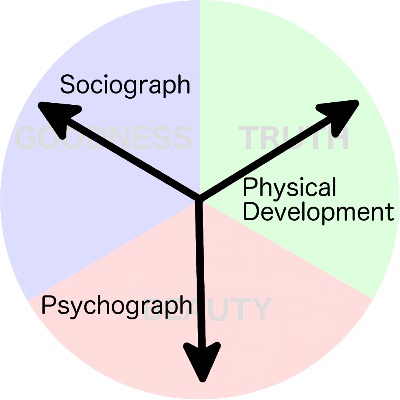 Personality typesKen also mentions personality type as an important perspective lens to consider, an example of which is the popular Myers-Briggs model. The pattern of recursive holonics described by myself however shows up most clearly in the Enneagram system of personality types where the 9 personality types depicted in Figure 37 (from “What Enneagram Profile Type Am I?”) represent 3 primary types of Gut, Heart and Head, each of which has sub-types of Gut, Heart and Head. Since Gut, Heart and Head map to Beauty, Goodness and Truth in my model, this diagram can be drawn as the recursive holonic diagram shown in Figure 38. The Primary personality types of Gut, Heart and Head map to the Beauty, Goodness and Truth dimensions of the main circle. Each of those primary types contains a group of 3 sub-types (of Gut, Heart and Head), these map to the Beauty, Goodness and Truth sub-dimensions depicted by each of the 3 sub-circles. 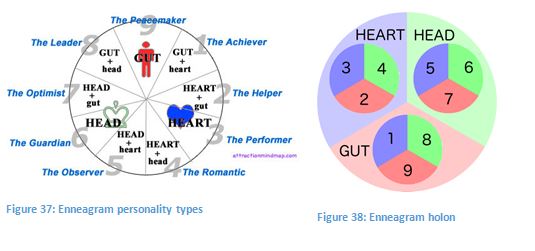 Ken’s holon typesKen Wilber defines various holon types which although not the same thing as the holon types in my model, nevertheless have strong resonances with my holon types. These mappings are shown in Table 5. 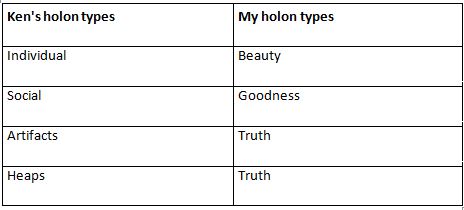 As with the quadrants of AQAL, there are 2 separate holon type mappings to my single Truth holon type, the reasons appear to be similar here since I would regard Artefacts as the “I” sub-dimension of a Truth holon type, and Heaps as the “WE” sub-dimension of a Truth holon type. Note that the above comparisons are resonances rather than direct mappings – in my system, a multicellular sponge with no nervous system would be classified as a “Goodness” holon, whereas I’m quite sure that Ken would classify this entity as an “Individual” holon (rather than a “Social” holon). Holon types as described by myself aren’t recorded within Ken’s model, and Ken’s holon types should be thought of as existing in addition to the holon types defined in my model. Ken’s holarchy stagesThe mapping between the stages in the natural holarchy identified by Ken versus the stages I have identified are shown in Table 6. 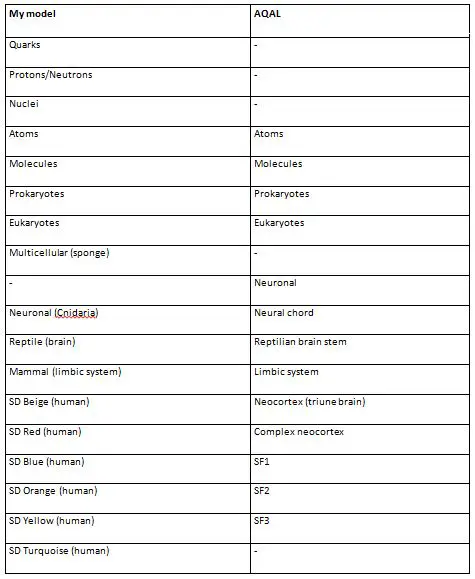 Essentially the staged identified in the two models line up, with the exception of my finding a holonic stage existing at the level of emergent multicellularity (e.g. a sponge or gonium pectorale) whereas Wilber does not seem to recognize multicellularity as a holonic stage but does find a differentiation between Neuronal and Neural chord. SummaryA 3D BGT holon model may be used to move towards an integration of various distinctions that appear in Wilber AQAL, such as the 3 different context applications of the 4 quadrant AQAL model together with the different dimensional structures of each of these 3 different AQAL model applications. Also described in terms of BGT holonics are the IMP model as a cube existing in BGT dimensions, personality types as BGT enneagram holon and lines of development as recursively differentiated BGT holonic dimensions. MAPPING TO COOK-GREUTER EDTSusanne Cook-Greuter has chosen a 3D holonic lens similar to my own as the foundation her analysis. From her writing: “EDT describes a psycho-logical (sic) system with three major interrelated components or dimensions of meaning-making”. These dimensions are referred to in her writing as Doing (behavioral dimension), Being (emotional dimension) and Thinking (cognitive dimension). In my opinion, Susanne’s three “dimensions of meaning-making” are compatible with the three “holonic dimensions” in my own model, with Doing, Being and Thinking mapping to my holonic dimensions of Beauty, Goodness and Truth respectively. EDT identifies a more nuanced developmental landscape than many other theories, since Susanne identifies a “differentiation” and “integration” sub-stage for each main stage, together with noticing all conventional stages have an overriding principle of “differentiation” and all post-conventional stages have an overriding principle of “integration” – this is shown in Figure 39 (diagram from EDT). 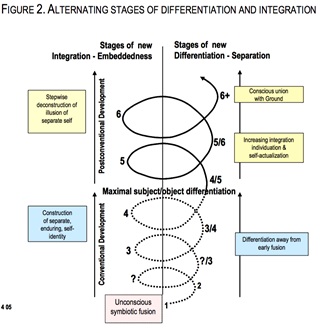 From my own assessment of the descriptions Susanne gives to each stage, my mapping of EDT to my own theory is shown in Table 7. 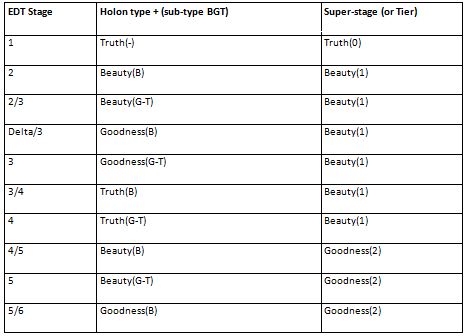 The holon BGT type for each EDT stage is shown in column 2, the letters in brackets that appear after the holon type represent a BGT sub-stage classification as per the previous section on recursion. Column 3 contains super-stage (or tier) classification, also as per the previous section on recursion. The emergence of sequential Beauty, Goodness and Truth type holons as expected by my model is clearly visible in EDT (column 2 in above table), pairs of each type of holon type are in evidence due to EDT identifying 2 sub-stages for each primary stage. A sense of a repeating pattern is also visible in the following statement in Susanne’s theory: “In our observation, two stages (2/3 and 4/5) express the same underlying structure of meaning in two significantly different ways”. This observation does fit in with my own theory since stages 2/3 and 4/5 are both Beauty holons and therefore have significant systemic resonances. The “fit” with my own model may, however, be slightly better between stages 2/3 and 5 since these are both Beauty(G-T) holons. As noted, Susanne sub-divides major stages into differentiation and integration sub-stages, I have mapped these to BGT as per the previous section on 2nd person perspectives by equating differentiation with Beauty (B) and integration with a point between Goodness and Truth (G-T). This mapping may not be wholly accurate, some of Susanne’s integration sub-stages seem to be defined more in terms of G and others more in terms of T, so it’s possible that a more accurate mapping would simply select one of G or T perspectives as the “integration” mapping rather than G-T. Alternatively, it’s possible that the differentiation/integration sub-stages identified by Susanne do not map to 3 BGT sub-stages and are descriptive of some other binary rather than trinary process. Some evidence is present that they do map however, namely Suzanne describes the sub-stages in terms of a 2D differentiation/integration perspective but represents this process using a 3D spiral (Figure 39), this seems to demonstrate awareness that even though she’s used a 2D conceptual mapping, the underlying process can be described using a 3D (spiral) concept space. Furthermore, my model predicts (infinite) recursive sub-stages, so is expecting the sub-stages and the sequence and systemic principles of Susanne’s sub-stages (differentiation followed by integration) matches the sequence expected by my model, e.g. B followed by G-T. As previously mentioned, in addition to predicting recursive sub-stages, my model also predicts recursive super-stages. Because the emerging holon type repeats every 3 emergences, a group of 3 emergent holons can be referred to as a super-stage, or (to use Spiral Dynamics language) every 3 emergent holons represents a tier. Because of this, my model predicts a fundamental systemic shift will occur every 3 primary EDT stages (or 6 sub-stages). And in fact, just such a shift is visible within EDT, since Susanne notes that the overall principle of the 1st 6 EDT stages is differentiation, after which the overall principle shifts to integration, as shown in Figure 40 (diagram from EDT). 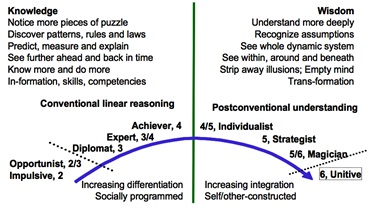 Mapping this directly to my model does rely on the idea that the previous tier boundary can be found between EDT’s stage 1 and stage 2. But since stage 2 represents the emergence of the first primitive dimension of human reflective self-awareness which then progressively unfolds in the following 3 major stages, it does meet the conditions for being regarded a tier boundary under my model – this tier (or super-stage) mapping is shown in column 4 of the above table. MAPPING TO SPIRAL DYNAMICSMapping between the stages identified by Spiral Dynamics (SD) and the holon types of my model is shown in Table 8, using holon sub-type labelling to identify holonic stages that SD differentiates into sub-stages as per my previous EDT mapping: 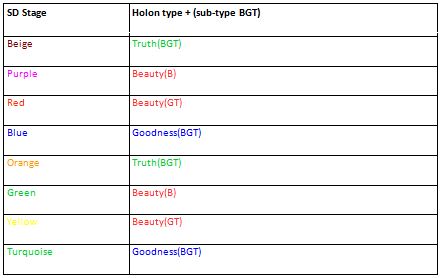 Notes:
It’s not altogether clear why SD should only differentiate Beauty holons into 2 sub-stages (Purple/Red and Green/Yellow) and define Goodness and Truth holon stages (e.g. Beige, Blue, Orange and Turquoise) without any sub-stage differentiation. Reasons might be that these further differentiations fell in a blind spot of the questionnaire used to gather the data that was originally used to form the theory, it’s also possible that the authors of the theory spent a greater time studying and differentiating a developmental move that was historically topical for them (the shift from Orange to Green to Yellow). An alternative hypothesis here might be that if all SD stages are considered as primary stages, SD’s repeating pattern of 4 stages is evidence that Ken Wilber’s 4 quadrant model is a correct mapping of holonic reality, and that my own 3D model omits a primary domain. Cook-Greuter’s EDT provides evidence this is not so however, since it also maps Purple/Red and Green/Yellow to sub-stages. Why I chose Green to represent SD OrangeMy model makes use of Red, Blue and Green which are primary colors and therefore sum to zero, e.g. an equal mix of Red, Blue and Green light creates white light. Since I regard Beauty, Goodness and Truth as fundamental perspectives of the absolute, it is correct that they all should all sum to zero (the formless ground of being), so from that basis Red, Blue and Green are “correct” in that they are meaningfully descriptive of the underlying phenomenon. Furthermore, the holonic theory I have described may also be applied to color theory, within that, it’s my view that regarding a “color holon”, its Red component is its dimension of Beauty, its Blue component is its dimension of Goodness and its Green component is its dimension of Truth. From that view, the colors chosen to represent these holonic principles are in fact the “correct” colors for the representation. It’s not uncommon to see these 3 primary colors used in the way I have used them to represent Beauty, Goodness and Truth perspectives, as you may start noticing now that I have mentioned it! MAPPING TO AQAL CUBELex Neale’s AQAL Cube theory is a product of his own research on consciousness perspectives and the structure defined in his model essentially appears as a result of mapping out the structure of human pronoun-perspectives (which according to Lex occurs as a constant across cultures and languages). Lex’s theory does, however, resonate strongly with the work of Ken Wilber, and is considered by Lex to be a natural development of Ken’s AQAL. Lex notes that “any personal pronoun is a combination of three polarities: subjective or objective, singular or plural, and possessive or non-possessive”. In other words, he notices that language is formed from a set of 3 polarities, 2 of which (subjective or objective, singular or plural) are the polarities which form Ken Wilber’s AQAL square, and one of which (possessive or non-possessive) isn’t specifically identified in Wilber’s model (except possibly later as the extra distinction found in Ken’s IMP, introduced in 2006). Lex’s model effectively represents this extra polarity by adding an extra dimension to Ken’s AQAL square, thereby creating the cube shown in Figure 41 in which Ken’s AQAL square is differentiated into an “upper” and a “lower” by adding a new vertical dimension into the model. 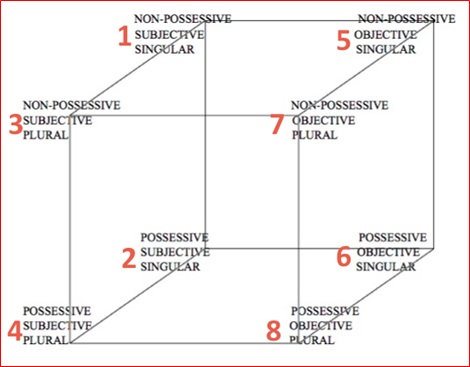 Since Lex’s cube (with its 3 orthogonal pairs of constituent polarities) effectively describes a 3D perspective space, it maps more cleanly to my own trinary model than Ken’s 2 polarity AQAL. An analogy of the conceptual mapping between Lex’s AQAL cube and my model might be to consider a theatrical production either from the perspective of the stage (the space) or from the actors on the stage (the content). My model defines a 3D perspective-space formed from the 3 orthogonal dimensions of BGT (see Figure 25), so in a sense, my model defines the stage. Lex’s cube on the other hand describes the situation by mapping the linguistic structure that humans have placed inside the perspective space – the actors on the stage. However, the important point here is simply that we both describe perspective space as having essentially 3 dimensions. Lex also notes that this cube exists in 3 person perspectives, e.g. 1st, 2nd and 3rd person, this creates a set of 3 cubes shown in Figure 42, which account for a total of 24 pronoun-perspectives (8 in each person perspective), this is shown in Figure 42. 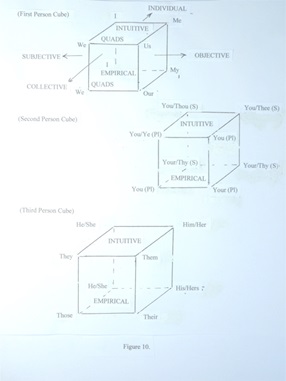 Since 1st, 2nd and 3rd person perspectives can be related to the 3 Beauty, Goodness and Truth dimensions of a holon in my model, and since each person-perspective cube itself represents a 3D perspective space, there is a sense of the 3 cube AQAL model representing a 3D perspective space that’s had each of its dimensions recursively differentiated into 3 sub-dimensions. A mapping of AQAL cube to my own model is possible by considering that the first person cube shown in Figure 43 contains evidence of three separate dimensional emergences of the type described by Robert Kegan through which subject becomes object, namely:
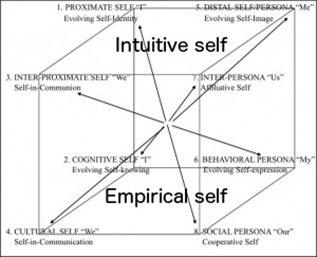 Visible in the above list is an emergent sequence of I, WE, IT (or Beauty, Goodness, Truth) although simply assuming these are 3 sequential emergences does not integrate the 3 separate cubes of the 3 person perspectives. In order to integrate the cubes, it’s useful to note that Lex considers the empirical self to be a local (e.g. inside space-time) self, and whereas the intuitive self is considered a nonlocal (intangible and formless) self. In fact, considered as holonic emergences, 3 “formless IT” emergences are clearly visible in the holarchy, these emergences can be understood by considering triune brain theory. 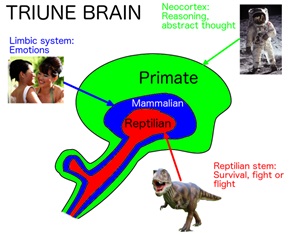 Figure 44 is an illustration of MacLean’s theory of a triune brain, whereby the human brain is seen as having 3 physical layers which emerged over the course of human evolutionary history. This maps directly to my theory as 3 sequential holonic emergences of I (reptilian), WE (mammalian) and IT (primate), alternatively expressed as sequential emergences of Beauty, Goodness and Truth. However – something extremely important is missing from this diagram. The triune brain itself as a physical 3-layer structure has remained essentially unchanged since the appearance SD Beige humans. Before and up to SD Beige, every holonic emergence in the holarchy from quarks to primates has a very obvious physical dimension to it, e.g. in the evolution from reptiles to primates, 3 successive physical layers are added to the brain resulting in the triune brain. However, all stages of emergence subsequent to SD Beige lack any obvious physical dimension to the holon, e.g. they occur without adding any new visible layers to the triune brain. As an aside, I would argue that human holonic emergences subsequent to SD Beige do have some sort of “IT” dimension, it’s just that the structure is more abstract, possibly even conceptually existing within a zero-dimensional space-time point. But the simple fact remains that, unlike all prior stages in the holarchy, stages after Beige have no obvious (easily discernable empirical space-time object) IT dimension. The holonic emergences subsequent to SD Beige can be considered as the point on the holarchy where human reflective self-consciousness emerges, which happens sequentially in the 3 dimensions of I, WE, IT with the sequential emergence of SD Red, Blue and Orange (Beauty, Goodness and Truth in my model). Considering therefore the holonic representation of a modern rational worldview (e.g. SD Orange) human in Figure 45, three major stages of emergence (SD Red, Blue and Orange) have occurred subsequent to the (Beige) appearance of the triune brain, how these emergences show up in the reality experience of an SD Orange human is depicted in Figure 45. In a sense, the I, WE and IT of the triune brain have been turned into 3 objects of consciousness with the emergence of a dimension of reflectivity in each of the holonic dimensions of the big circle. 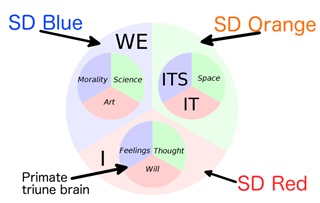 Since this human holon represents 3 holonic emergences that don’t have an obvious empirical IT dimension (SD Red, Blue and Orange), and since these emergences are in the 1st, 2nd and 3rd person respectively, these emergences map directly to Lex’s model as 3 sequential differentiations of “above quadrants” (intuitive) from “below quadrants” (empirical). Notice that these differentiations as historical emergences occurred in sequence through the 1st, 2nd and 3rd person cubes respectively. In terms of a Spiral Dynamics color coding, the emergence of Red, Blue and Orange is represented as sequential vertical differentiations on the 3 person-perspective cubes in Figure 46, the cubes can be considered as 3 stages on the holarchy spiral of emergence. 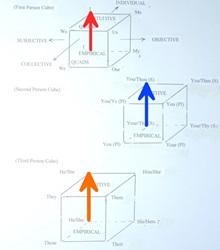 (Note: in terms of holon type, SD Orange maps to Green in my BGT model, and the above diagram maps the spiral of emergence upside down since the correct sequence of emergence is SD Red, SD Blue, SD Orange) So the mapping between my model and the AQAL cube is to understand that the holarchy spiral of emergence as described by myself actually weaves sequentially and endlessly through the 3 cubes. However, the cubes themselves are 3D entities and only a single dimension of cube differentiation has been shown above. If we are to consider the emergence of the other 2 cube dimensions, this involves looking further back down the holarchy, e.g. the previous cube dimension describes the emergence of the triune brain itself in terms of 3 stages of emergence: reptiles, mammals and primates. To take a big-picture view on how the AQAL cube can map to the holarchy, the 3 cubes can be represented as a single cube if the 3 person perspectives aren’t differentiated, the 3 dimensions of such a cube each map to a holonic super-stage in my model (3 sequential emergences grouped into a single super-stage) and it is interesting to trace the spiral of emergence though this single cube, shown in Figure 47. Within such a representation, the 3 vertical differentiations shown in Figure 46 become a single differentiation on the cube (the green arrow in Figure 47). Because this differentiation represents 3 major stages of emergence (SD Red, Blue and Orange), it represents the differentiation of (SD Orange) human beings from primates, hence I have labelled it “Humans”. Moving further back down the holarchy, the previous super-stage is the emergence of the primate triune brain itself, the arrow in blue represents the sequence of emergence from neuronal organisms (jellyfish) to primates. The Next super-stage (in red, labelled as “Nervous system”) contains the 3 stages of emergence from a single-cell eukaryote organism to a neuronal organism such as a jellyfish. 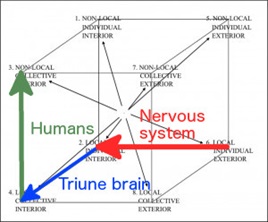 In terms of a holonic dimensionalizing of consciousness, this single cube therefore represents the entire holarchy from eukaryote single-celled organisms to an SD Orange human, this gives a sense of the holonic depth that is involved in providing our day to day reality experience. The color coding I’ve used represents the BGT type of each super-stage as identified from the particular cube dimension being differentiated, e.g. the super-stages sequentially emerge through the perspectives of I, WE and IT on the cube. The above example maps an AQAL cube to a specific point on the holarchy (SD Orange), the cube itself is an abstract construct which may be applied to any point on the holarchy, so is not tied to simply describing human beings at any particular level of development. Note: Lex has pointed out that the above is based on his earlier work, a more updated version of his thinking is available here (as an abstract model however, the set of 3 cubes remains essentially unchanged). MAPPING TO STEVE MCINTOSH’S WORKLike myself, Steve McIntosh places Beauty, Goodness and Truth center stage in his writing, and I find strong resonances between his work as presented on Integral World and my own thinking, for example Steve also notices the recursive nature of BGT which he calls the “The self-similar patterning of evolution’s Cosmogenetic Principle in nature, self, and culture” depicted in Figure 17. A key difference between our thinking is that Steve seems to conceptualize BGT primarily in terms of values, whereas my own perspective is to talk primarily in terms of BGT expressions, this difference causes apparent contradictions unless perspective is considered and translated. A map of Steve’s values of BGT and my expressions of BGT using Yin and Yang as a reference is shown in Table 9.  A translation between these perspectives can be made using the following: “Truth is good and beautiful; goodness is true and beautiful; beauty is true and good. But there is an ontological (not temporal) order: it flows from Being to truth, truth to goodness, and goodness to beauty. Truth is judged by Being, goodness by truth, and beauty by goodness.” — Peter Kreeft (C.S. Lewis as Philosopher, p.33) From the above, value of is a relationship with an expression of. Since value is a judgement, and since Beauty is judged by Goodness, I would say that “value of Beauty” = “expression of Goodness”, which maps Steve’s yin perspective to mine. Additionally, since Truth is judged by Beauty (or Being), “value of Truth” = “expression of Beauty”, the same transformation works for our respective perspectives of what is yang. Because however I am using the concepts of Beauty, Goodness and Truth as the primary categories of a sparse ontology (despite thinking primarily in terms of expression of BGT), my own perspective can happily accommodate both values of BGT and expressions of BGT, since both are just perspectives of BGT considered as transcendentals. This does mean that Steve’s thinking is fully compatible with my thinking since it may be just a subset of it, so his own thinking may not be able to find a place for mine without perceiving errors. A further difference between Steve’s writing and my own is the respective sequence of BGT that we both reference. I use the sequence BGT whereas Steve uses the sequence BTG. Both sequences are in common use, the above quote by Peter Kreeft indicates that he regards the BTG sequence used by Steve to be an ontological sequence since I am talking about the temporal sequence of BGT, I feel our different sequence perspectives are still compatible. MAPPING TO ELENA MALEC’S THEORY OF KNOWLEDGE EVOLUTIONElena Malec’s theory of the sociocultural evolution of human knowledge takes a similar perspective to Spiral Dynamics by considering sociocultural evolution in terms of worldview value systems, the historical timing of the emergence of the stages also seems to line up with those reported by Spiral Dynamics. Of note, however, is that the values in Elena’s theory are described in terms of Beauty, Goodness and Truth as per my model, and the stages she identifies as having an orientation towards Beauty, Goodness and Truth match the corresponding BGT holon types I myself list for the historical stages of human emergence she discusses. From her writing:
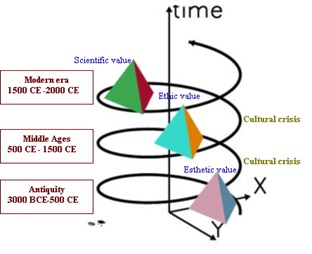 Author: Phil Anderson APPENDIXHolonic theories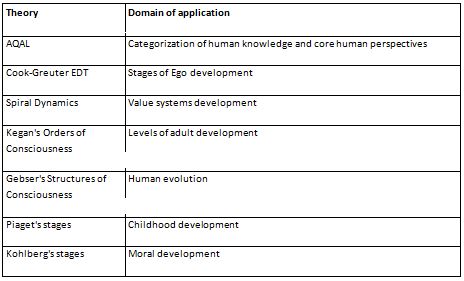 A practical example of recursive analysisAs defined, the qualities of Beauty, Goodness and Truth are themselves formed from subordinate sub-dimensions of Beauty, Goodness and Truth, this can be used to analyze any occurrence. For example, considering the quality of Goodness, I (as a holon) can offer someone Goodness actively through self-expression (e.g. subordinate Beauty) by weeding their garden, or I can offer someone Goodness passively through self-sacrifice (e.g. subordinate Goodness) by offering them my last chocolate. I can also offer someone Goodness simply by being physically present and available to help them develop their ideas (subordinate Truth). Because Beauty, Goodness and Truth can each be differentiated into subordinate sub-dimensions of Beauty, Goodness and Truth, I could even take the subordinate dimensions identified above and further differentiate each of them, in effect into sub-sub-dimensions of the original qualities. Example: As noted, I can offer someone Goodness simply by being available to help them develop their ideas (subordinate Truth). That subordinate Truth itself has 3 dimensions to it though, I could offer them my own ideas (self-expression, subordinate Beauty), I could take an interest in the person’s ideas and ask questions (self-sacrifice so subordinate Goodness), or I could just witness the person explaining their ideas without comment (e.g. just provide a sense of conceptual space and presence). Each one of these different behavior styles has the capacity to help the person develop their thinking. So, in recap – taking the above case where I offer the person my own ideas: I can offer someone Goodness by offering them a subordinate Truth which in turn is based on a subordinate Beauty. Note that however deep we go with our recursion, Figure 22 remains a true depiction of the holon’s dimensions, because all we are doing is adding further historical layers of Beauty, Goodness and Truth emergence. However far down the spiral we consider, even if we consider the entire (infinite) spiral, this image remains an accurate depiction of any holon. Space is inside BGTTo understand where Space itself fits in to my model, consider the holon diagram in Figure 49 of a modern SD Orange human, in which Space appears as one of the 3 sub-dimensions of the holon’s Truth (or IT) dimension. However, space itself can be recursively differentiated as shown Figure 49 where the single Space sub-dimension (labelled SPACE) has been differentiated into the 3 (orthogonal) spatial dimensions we are familiar with in our everyday existence. The 3 dimensions of Space are labelled X, Y and Z although these could also be labelled as the Beauty, Goodness and Truth (sub) dimensions of Space. Because each dimension of Space is abstract and empty, it’s not empirically possible to identify a dimension of space as being of type Beauty, Goodness or Truth, nevertheless it remains “true” within this model that they could be thus labelled. Note: it’s possible to look at Space from 2 perspectives – either the perspective that Space is a quality of the universe (e.g. it’s “out there”) or that space is a projection of our own looking at the universe, e.g. Space is consciousness. Both perspectives are simultaneously correct (e.g. both are just perspectives of an underlying reality which is not dualistic). Note that the view offered in this holonic diagram is a “stepping back” from the rational worldview / European enlightenment perspective that space contains entities (such as ourselves), and a stepping into the perspective that holonic being-ness contains space. As a holon, the universe is inside of us, not vice versa. Notice that in Figure 49, 3D space (e.g. the Universe) exists merely as a sub-dimension of a sub-dimension of our holonic model, meaning that the holonic model itself describes and occupies a higher order dimensionality beyond conventional space-time. 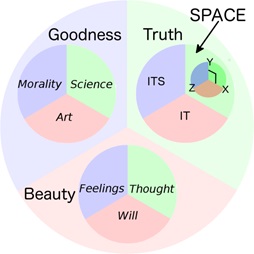 Image attribution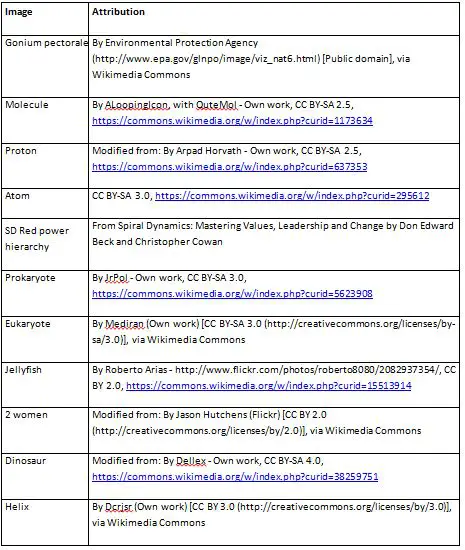 |